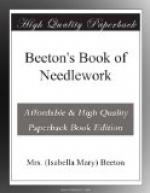[Illustration: 454.—Escalier Lace Worked in Diamonds.]
No. 455.—SPANISH POINT LACE is adorned with highly-raised scrolls, flowers, &c. This is effected by working over an underlay of coarse white thread or over fine white linen cords. The wheels are worked by winding soft coarse linen thread round pencils or smooth knitting-pins of various sizes, and working over the circle thus obtained a succession of close button-hole stitches. These wheels are sewn on to the lace when completed. The groundwork of Spanish lace is usually worked in what are called Raleigh Bars (see page 477), but this lace has sometimes for groundwork point de Venise. An easy mode of working this handsome lace is to trace the design upon very fine good linen; raise the thick parts as above directed, and embroider the whole in fine thick scalloped button-hole stitch; fill the ground with Raleigh bars, or, as shown in illustration No. 455, in treble point de Venise, and cut away the linen from beneath the groundwork.
[Illustration: 455.—Spanish Point Lace (Worked a l’Anglaise).]
WHEELS AND ROSETTES.
Wheels or rosettes are used to fill up circles, or in combination to form lace. The simplest is—
THE SORRENTO WHEEL.—Nos. 456 and 457.—This is worked by fastening the thread in the pattern to be filled up by means of the letters. Fasten it first at the place a, then at the place b, carrying it back to the middle of the first formed bar by winding it round, fasten the cotton at the place c, carrying it back again to the centre by winding it round the bar, and so on; then work over and under the bars thus formed as in English lace. See page 462, and illustrations Nos. 456 and 457.
[Illustration: 456 and 457.—Sorrento Wheels.]
No. 458.—ENGLISH WHEEL.—This is worked in the same manner as the Sorrento wheel, but instead of winding the thread over and under the bars, the needle is inserted under each bar and brought out again between the thread and the last stitch; this gives a kind of button-hole stitch, and gives the square, firm appearance possessed by this wheel.
[Illustration: 458.—English Wheel.]
No. 459.—ROSETTE IN POINT D’ANGLETERRE.—This rosette is worked in a somewhat similar manner to the wheel above described, the difference being that after each stitch passed round and under the bars, the thread is passed loosely round in the reverse direction, as shown in illustration No. 459, before proceeding to make the next stitch.
[Illustration: 459.—Rosette in Raised Point d’Angleterre.]




